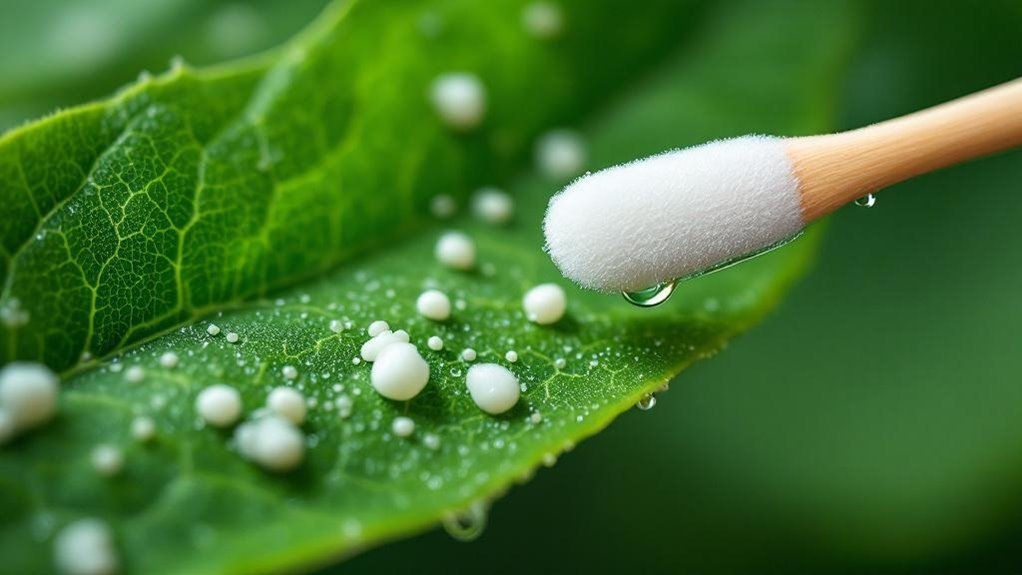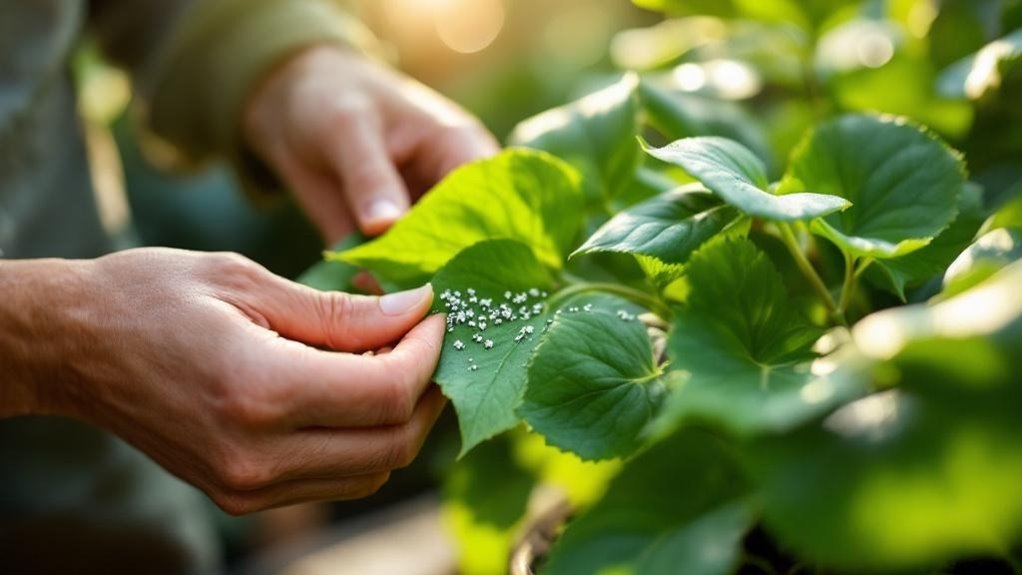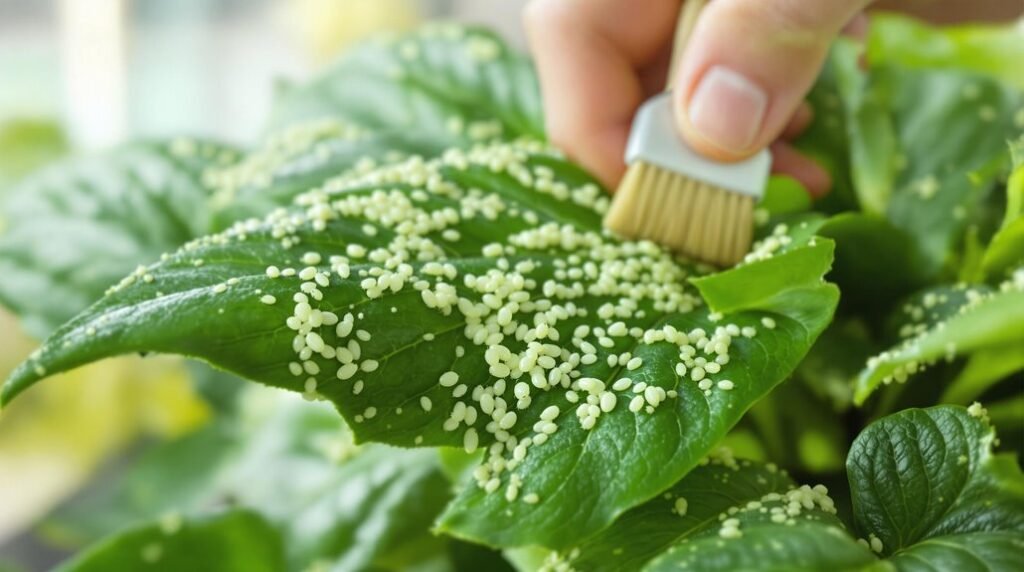If you’ve noticed sticky residue or yellowing leaves on your plants, you might be dealing with scale insects. These pests can silently weaken your greenery, making timely action essential. Fortunately, there are effective ways to identify and control them before they cause serious damage. Understanding the best removal methods could be the key to restoring your plants’ health and vigor.
What Are Scale Insects?
Although scale insects are tiny, they can cause significant damage to your plants. To identify scale, look for small, immobile pests attached to stems, leaves, or branches.
You’ll notice two main types: soft scale, which secretes sticky honeydew deposits attracting fungi and other pests, and armored scale, with a hard shell that doesn’t produce honeydew.
Both types harm plants by sucking sap, leading to visible indicators like yellowing leaves, wilting, and sooty mold.
Scale insects drain plant sap, causing yellow leaves, wilting, and sooty mold buildup.
If you spot these signs, it’s essential to remove scale promptly to prevent plant disease and further damage. Knowing how to identify scale insects early gives you a better chance to protect your plants and maintain their health effectively.
Types of Scale Insects
Scale insects come in two main types: armored and soft scale. You’ll notice armored scale insects have a hard protective covering that isn’t attached to their bodies and don’t produce honeydew.
Soft scale insects, however, secrete a waxy covering that’s part of their body and produce honeydew, attracting ants and promoting mold growth.
Here’s what you should know about these types:
- Armored scale infest outdoor trees and shrubs and are tough to remove because of their shield-like covering.
- Soft scale are larger, can move short distances, and often infest indoor plants or greenhouses.
- Mealybugs, a kind of soft scale, appear white and cottony, producing significant honeydew during an infestation.
Their coloration varies widely, from black and white to amber and yellow, making identification essential.
How to Recognize Scale Infestations

Identifying an infestation starts with knowing what to look for on your plants. To identify a scale infestation, check for small, shell-like bumps on stems, leaves, and branches. These bumps range in color from brown to white or tan and are the protective scale covering adult females. Their immobile nature makes them easy to spot once attached.
Another key sign is sticky honeydew on leaves, which often leads to sooty mold. Early detection is vital, so regularly monitor your plants for these indicators.
While signs of scale damage like yellowed, distorted, or prematurely dropping leaves signal cellular damage and sap loss, focus first on spotting the insects themselves. Catching scale early helps you act swiftly to protect your plants from severe harm.
Identifying Scale Damage on Plants
When you notice clusters of small, shell-like bumps on your plant’s leaves, stems, or bark, it often signals sap-sucking pests feeding and weakening your plant. Identifying scale damage early helps protect your plants from severe harm.
Look for these symptoms of infestation:
- Yellowing, wilting, or dropping leaves caused by scale feeding damage
- Sticky honeydew secretion that encourages black sooty mold growth
- Dappled or distorted leaves with brown “scabs” from scale activity
These signs indicate that scale insects are harming your plants by draining essential sap.
Regularly inspecting your plants for these symptoms and honeydew buildup is important for identifying scale damage early. Catching an infestation in time lets you act before your plants lose vigor or suffer stunted growth.
Effective Methods for Scale Removal

Although dealing with scale insects can be frustrating, you can remove them effectively by combining targeted treatments and regular monitoring.
Start by applying a mixture of rubbing alcohol and water directly to the plant’s infested branches using a cotton swab or spray bottle. This helps in removing scale bugs on contact.
Next, use horticultural oil, like neem oil, which suffocates the pests when applied every 2-3 days during their crawler stage.
Prune heavily infested branches and seal them in bags to prevent spreading.
Keep checking for signs like honeydew or sooty mold to catch infestations early.
These methods allow you to control scale bugs without harming beneficial insects, ensuring your plant stays healthy and pest-free over time.
Using Natural Predators for Control
Because natural predators specifically target scale insects, you can rely on them as an effective and eco-friendly way to control infestations.
Using biological control with beneficial insects like ladybugs and parasitic wasps helps reduce scale populations sustainably. Ladybugs consume up to 50 scale insects daily, while parasitic wasps lay eggs inside scale insects, eventually killing them.
To encourage these natural predators, create a garden habitat that supports their needs.
- Introduce ladybugs to actively reduce scale insects.
- Plant nectar-rich flowers to attract beneficial insects.
- Maintain biodiversity to strengthen your garden’s ecosystem.
Applying Horticultural and Neem Oils
To effectively control scale insects, you’ll want to apply horticultural and neem oils at the right time and in the proper way. Horticultural oils suffocate scale insects and work best during the crawler stage. Make certain to cover all plant surfaces, including undersides of leaves. Neem oil kills established scales and deters future infestations, acting as both pesticide and growth regulator. Apply these oils during cooler parts of the day and avoid direct sunlight to protect your plants.
| Oil Type | Application Tips |
|---|---|
| Horticultural | Mix 2-5 oz per gallon; spray in late spring |
| Neem | Mix 1-2 tbsp per gallon + detergent; repeat regularly |
| Both | Apply evenly on all plant surfaces; avoid heat above 90°F |
Regular applications guarantee effective control and prevention.
Preventing Scale Infestations
How can you keep scale insects from taking hold in your garden? To prevent scale, focus on maintaining strong plant health and practicing vigilant care.
Start by inspecting new plants thoroughly and quarantining them for a few weeks before adding them to your collection. Choose resistant species to reduce vulnerability.
Keep your growing area clean and free of debris, which can harbor pests, and guarantee good air circulation around plants to lower stress and discourage infestations.
You should also wash leaves regularly with a mild soap solution to remove any early signs of pests. Regularly monitoring your plants helps catch problems early and keeps pest infestations at bay.
- Inspect new plants carefully and quarantine them.
- Select resistant species suited to your environment.
- Clean the growing area and wash leaves frequently.
Managing Scale on Indoor Plants
Even with careful prevention, scale insects can still find their way onto your indoor plants, especially since warmer indoor temperatures and fewer natural predators create an inviting environment for them.
To control scale, inspect your plants regularly for clusters of shell-like bumps and signs of sooty mold caused by sticky honeydew. Rid insects by using a cotton swab dipped in rubbing alcohol to remove visible pests, making monitoring easier.
Quarantine infested plants away from healthy ones to prevent spread, and prune heavily infested branches.
Applying horticultural oil is effective at smothering scale insects, but be sure to hydrate plants well beforehand. You’ll need several applications of oil or insecticidal soap over weeks to fully manage the infestation and protect your indoor greenery.
Frequently Asked Questions
Can You Save a Plant With Scale?
You can save a plant with scale if you catch it early. Regularly check for signs, prune infested areas, apply treatments like horticultural oil, and encourage beneficial insects to help control the infestation naturally.
Do Scale Insects Live in the Soil?
Imagine pests like uninvited guests who never leave your couch—scale insects don’t live in soil. They cling tightly to your plant’s stems and leaves, feeding on sap, so focus your removal efforts there, not underground.
What Kills Scale Insects on Plants?
You can kill scale insects with insecticidal soap or neem oil, targeting crawlers. Rubbing alcohol wipes them off immediately. For severe cases, use systemic insecticides cautiously. Repeat treatments every few days for best results.
How Do I Permanently Get Rid of Scales?
Think of scales like stubborn graffiti on your plants. To permanently erase them, you’ll catch crawlers in spring, spray insecticidal soap, prune infested branches, and invite ladybugs—nature’s cleanup crew—to keep your plants graffiti-free.
Final Thoughts
Now that you know how to spot and tackle scale insects, your plants are closer to a full recovery than you might think. But don’t get too comfortable just yet—these pests can be sneaky and persistent. Stay vigilant, keep treating during those critical crawler stages, and watch for any signs of return. With the right care and a bit of patience, you’ll soon see your plants thriving again, free from the grip of scale insects.
